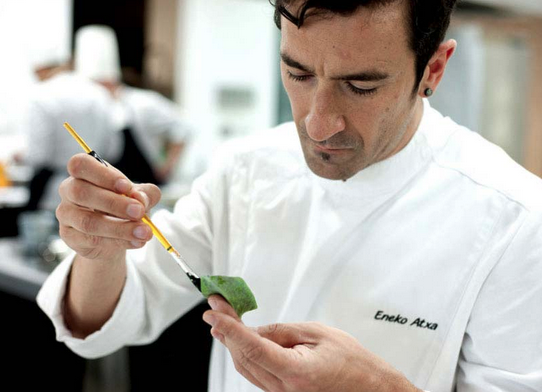This Basque story begins with some French monks. In 2021, Carthusian monks from a small town in the French Alps decided they were going to limit the production of their Charteuse liqueur in order to “protect their monastic life and devote their time to solitude and prayer.”
In the U.S., that decision meant sales of the famed green liqueur would be limited. In stepped Henry Preiss, owner of a small U.S. distribution company Preiss Imports, who saw a neat opportunity to reintroduce the Basque liqueur Izarra.
Preiss Imports is a small family business in Southern California, which has brought many fine brands of liqueurs from around the globe for distribution in the United States. Many of the brands were unknown in the U.S. before Preiss Imports introduced them.
“Any cocktail that is made with Chartreuse can be made with Izarra,” said Alain Royer, who works with Preiss Imports, in a recent interview with Euskal Kazeta.
 Royer lived in the Basque Country for many years and was very familiar with the green and yellow liqueurs made of herbs.
Royer lived in the Basque Country for many years and was very familiar with the green and yellow liqueurs made of herbs.
Izarra means “the star” in Euskera, the Basque language. The green liqueur (Izarra berdea in Basque or Izarra verte in French) is made from a complex blend of plants and spices, including nutmeg, coriander seeds and leaves, fennel, elderflower, peppermint,, green walnut and prunes, among others, and Armagnac. In the yellow version (Izarra horia), honey is added to the final blend. The original formula dates back to 1906.
“Everybody knows Izarra…it’s the taste of the homeland,” says Royer. One of his favorite ways to drink Izarra is “neat,” but out of the freezer. The liqueur does not freeze because of the alcohol. His instructions: Put both bottles (green and yellow) in the freezer. Wait a day. “Drinking it neat is absolutely fantastic. It’s going to be very difficult not to have two or three.”

Izarra Over the Years
The herbal liqueur was first created in 1906 by botanist and pharmacist Joseph Grattau in Hendaye, France. He developed it from a formula that dated back to 1835. He moved the distillery to Baiona, in the French Basque Country, before WWII. Today’s label continues to bear Grattau’s signature.
Long before being known as a liqueur, Izarra was like its counterpart cousins, an elixir, a cure to many diseases.
“Those products were not initially produced for drinking pleasure but to cure illnesses,” according to Royer. “It is over centuries that that those elixirs were sweetened and prepared in a way that made them more palatable.” Many of these early concoctions were produced by monks, who had the education to write down the recipes. Later, they were followed by alchemists, the early version of pharmacists.
In the early 1900s, the Izarra brand prospered. Basque travelers took bottles of Izarra with them and production facilities were opened in Spain, Mexico, Argentina and Venezuela.

In the 1950s, Grattau commissioned the most talented poster designer of the time, Paul Colin, to create a poster that became famous, depicting a Basque dancer in front of a bottle of yellow Izarra, according to the Vedrenne website. These advertisements for Izarra became very popular and could frequently be found in Basque Country cafes, bars and hotels. You can buy an Izarra poster on Amazon.
The Grattau family sold Izarra to Cointreau in 1981, and the company moved production to its historical production site in Angers France. The Baiona production site was destroyed. It passed through various hands during that time and the liqueur lost some of its sheen.
But Izarra regained some traction in 2015, with the mixology craze, and it was included in many Basque cocktail recipes. In 2018, the Pages-Vedrenne Group gained distribution rights. Today, Izarra is produced in southwestern France, just north of the Basque Country.
Preiss Imports sees huge potential for Izarra in the U.S. because of the growing enthusiasm for mixed drinks.
“America,” notes Royer, “is the land of cocktails.“
To recreate the original flavor, the initial recipe was revised in 2019, with a greater concentration of plants and a reduced sugar content. Royer explains that this is also in response to a consumer interest in less sugar. In Royer’s view, this change served to boost the aroma of Izarra.
How to Drink Izarra
1. Neat, as a shot
2. In a brandy or snifter with ice
3. Ice cold, the bottle coming out of the freezer
In Cocktails
The Last Word
Equal parts (3/4 ounce):
Green Izarra, gin (or Mezcal), Maraschino liqueur, lime juice
Shake and strain
Naked and Famous
Equal parts:
Mezcal, Yellow Izarra, Aperol, Lime juice
Shake and strain
Bijou
1 1/2 ounces gin, 1 ounce sweet vermouth, 3/4 ounce sweet Vermouth, 2 dashes orange bitters. Optional: garnish with maraschino cherry
Shake and strain
Fernet Sour
Equal parts: Fernet-Branca, Green Izarra, lime juice, simple syrup
Shake and strain

In Desserts
Verte Chaud
For years, a Verte Chaud (Hot Green) was a popular après-ski drink in the French Alps. Simply add a shot of green Izarra to a mug of hot chocolate.
Top the Verte Chaud with this Izarra-spiked whipped cream.
1 cup heavy cream
2 ounces green Izarra
2 ounces simple syrup
Pinch of salt
In a mixing bowl or stand mixer, whip together all ingredients to medium peaks. Use a generous dollop in your spiked hot chocolate
On Ice Cream
Top a scoop of dried raisins with Izarra and let sit in the refrigerator overnight. The next day, pour the alcohol-infused raisins over a scoop of vanilla ice cream. Add a splash of Izarra from the freezer.




















